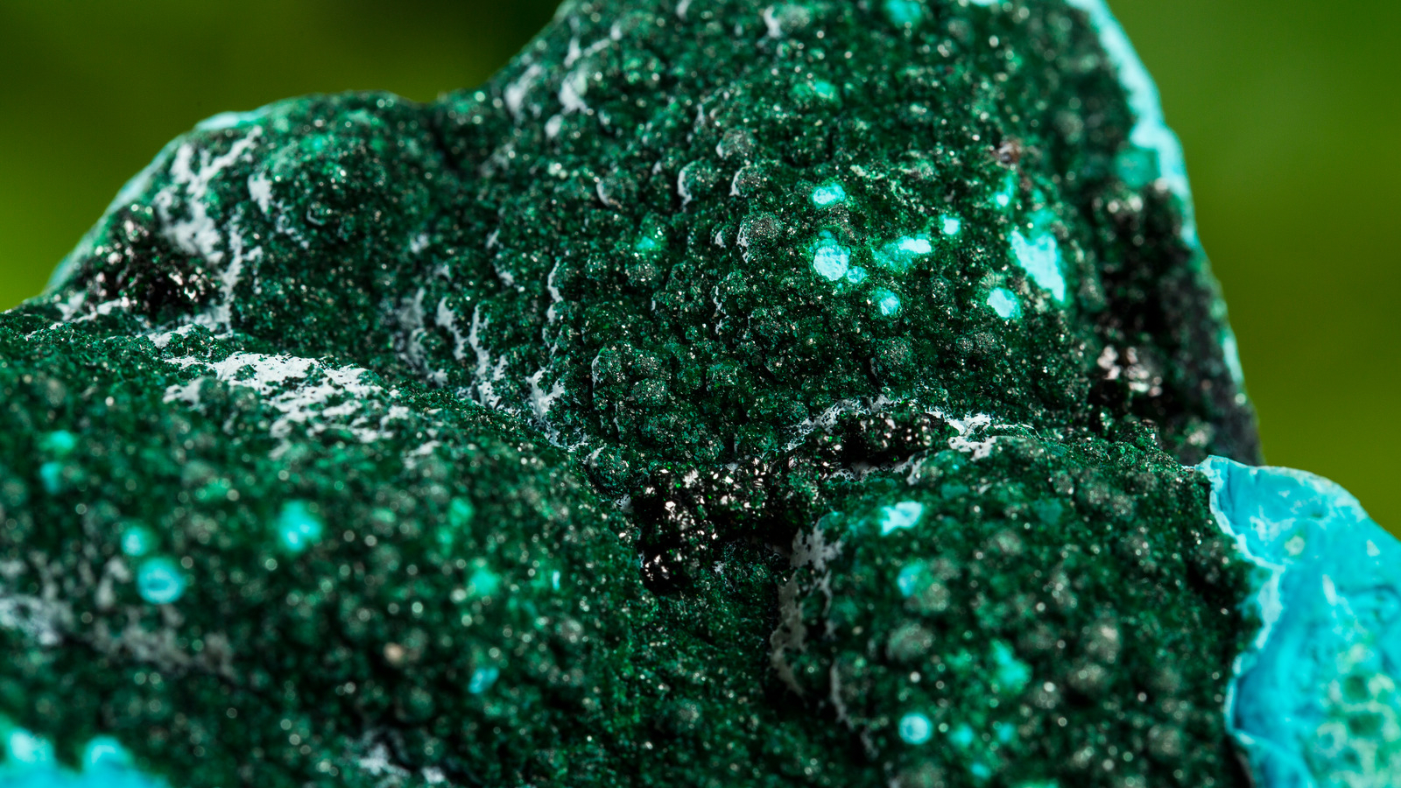Malachite is a soft yet resilient stone and is named after the Greek word ‘malakos’ meaning soft
What is Malachite?
Malachite is a semi-precious gemstone known for its striking green color and intricate patterns. This unique appearance has made it popular in jewelry and decorative arts for centuries.
Malachite is a copper carbonate hydroxide mineral. Its vibrant green color is the result of copper deposits within the crystal structure.

Malachite is a copper carbonate hydroxide mineral that is known for its striking green shades.
Meaning and Symbolism of Malachite
Malachite is known as the stone of transformation. Malachite represents strength to nurture growth and embrace the new.

A Stone for Transformation
Malachite, imbued with the wisdom of the ages, is a companion for those facing change. Whether you’re embracing new opportunities or teetering on the brink of a significant life shift, malachite offers the strength to nurture your growth and embrace the new.
Malachite is a special gemstone for Scorpios and Capricorns, aligning with Scorpio’s transformative energy and providing Capricorns with the courage to step out of their comfort zones.
Malachite is used in energy healing as a heart chakra stone. Malachite engages with the third eye and solar plexus chakras to clear blocks and fostering spiritual growth.
Malachite at a Glance
Colors
A spectrum of greens, from vibrant to yellowish tones.
Luster
Can be vitreous (glassy),
silky, or sometimes dull.
Transparency
Generally opaque.
Chemical Composition
Primarily Cu2(CO3)(OH)2 with potential impurities like Zn, Co, Ni.
Healing Properties of Malachite
Malachite is believed to be a powerhouse for warding off negative vibes, balancing emotions, and sparking creativity and intuition. It’s all about bringing a sense of satisfaction and joy to your life.
Malachite is a guardian of the heart and a purported healer of physical ailments. It’s believed to connect deeply with the heart chakra, promoting emotional release and encouraging bold steps outside one’s comfort zone.
While malachite is often attributed healing properties in various cultures, these claims are more rooted in metaphysical beliefs and do not have a basis in scientific research (yet).

Folklore, Historical Significance, and Uses of Malachite
Malachite holds a rich historical significance, for thousands of years it has been revered for its striking appearance and was often used for decorative purposes in jewelry, amulets, and artifacts.
- Ancient Uses: Malachite is the oldest known green pigment in paints.
- Cleopatra’s Gem: Legend has it that Cleopatra was so enamored with malachite that she was buried with a malachite vase. Cleopatra would also wear an eyeshadow made from malachite paste on her lower eyelids. The stone would be ground into a paste to create kohl. Malachite was believed to have cosmetic and protective properties by helping shield the eyes from the harsh desert sun and warding off evil spirits. 🚫 Don’t do this though. Ground malachite is toxic 🚫
- Aztec and Mayan Use: In the Americas, both the Aztecs and Mayans used malachite in their artwork and jewelry. It was carved into intricate masks and ornaments, showcasing the mineral’s significance in their cultures.
- Medieval Beliefs: Back in the day, it was hung above cribs as protection against evil and bad spirits.
- Russian Malachite Rooms: During the 18th and 19th centuries, malachite gained popularity in Russia. The Ural Mountains were a rich source of this mineral, and it was used to decorate various rooms in the Winter Palace and other royal residences, creating stunning “malachite rooms.” Malachite became a symbol of luxury and wealth.
Egyptians, Greeks, and Romans, among others, valued malachite not only for its aesthetic appeal but also for its believed metaphysical and healing properties.
How to Identify Malachite
Identifying malachite is straightforward due to its distinctive bright green color and banded light and dark green patterns. It’s typically opaque with a silky to glassy luster.
How to Pick Out Malachite
When selecting malachite, look for stones with intense green colors and well-defined banded patterns. Quality malachite should have a smooth surface with a glassy luster. The weight of malachite significantly influences its price. A small tumbled stone might cost you between $3 and $10.
When selecting malachite, craftsmanship and cut can drive up the price, especially for unique or artistic designs. Dark green stones with concentric circles are often the most coveted.

Approved by Naturalist’s Guide
Rock Identifier App
Use image recognition to identify stones, crystals, and gemstones.
Uses for Malachite
Apart from its use in jewelry and decorative items, malachite is also utilized in making catalysts, corrosion-resistant coatings, pigments, and pesticides. Its vibrant color and texture make it a versatile material.
Composition and Formation of Malachite
Malachite is composed of copper carbonate hydroxide (Cu2(CO3)(OH)2) and forms in the oxidation zones of copper deposits.
- Structure: Malachite forms in a monoclinic system, where chains of Cu and OH ions interlace with CO3 ions.
- Formation: It often appears due to the weathering of copper ores, commonly found alongside minerals like azurite and calcite.
- Global Presence: From the Urals in Russia to the deserts of Arizona, malachite’s presence is globally widespread.
How to Care for Malachite
Keep your malachite cleansed and recharged for optimal energy. Simple methods like washing with soapy water or recharging in nature can keep the stone at its best. Malachite requires careful handling. It should be kept away from harsh chemicals and extreme temperatures.
Frequently Asked Questions
What does Malachite do?
It’s a protective stone known for clearing negative energies and aiding in transformation.
What is Malachite good for?
Historically, it’s been a stone of protection and healing, especially connected to feminine energy and heart chakra alignment. It’s a favorite for jewelry, decorative pieces, and even for its purported healing properties.
How to clean Malachite?
Simple soapy water and a soft cloth will do; just ensure it’s kept away from harsh chemicals.
Is Malachite toxic?
Be cautious of inhaling it in its raw, powdered form.
Can you wear Malachite every day?
Absolutely! Just remember to treat it with care.








